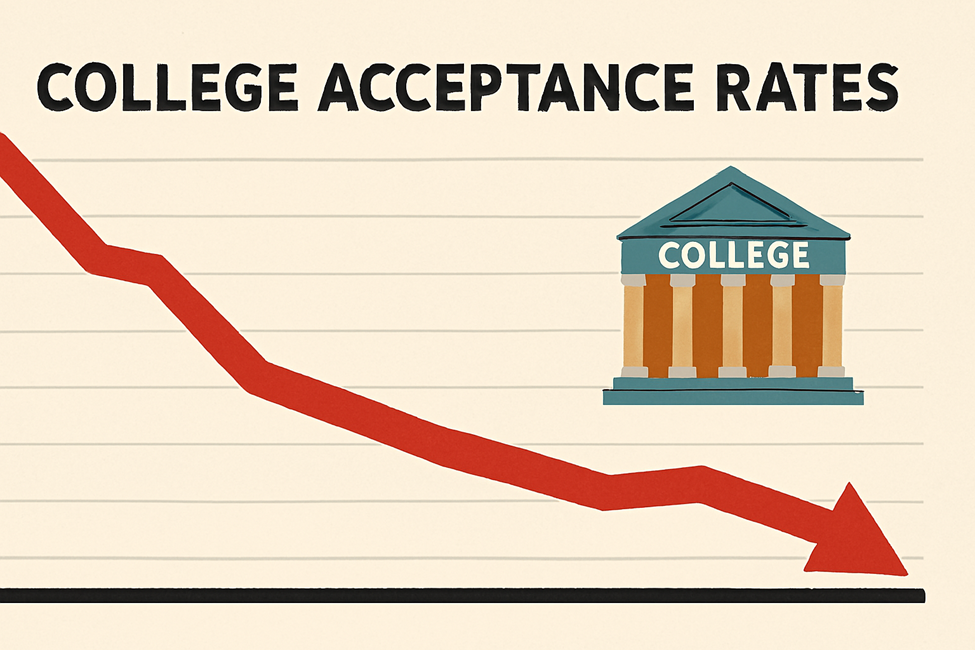* Terms and Conditions apply.



Image AI generated courtesy of Microsoft Copilot
Those of us who have been in the admissions game for a while have seen an alarming trend in falling (plummeting) acceptance rates, particularly among more prestigious schools found at the upper end of various rankings. I urge students and families to look at how those rankings are constructed, how most of it is completely irrelevant to undergrads, and to not put too much emphasis on any one number – for example: judging a school by its acceptance rate.
Often viewed as measure of institutional quality, school selectivity rates tend to become a central focus for prospective students attempting to get a handle on their admission prospect. This single number grossly oversimplifies the situation and depicts what I believe to be deceptive view of a much, much more complex admissions landscape. Relying solely on the overall acceptance rate obscures variations tied to specific academic programs and applicant backgrounds, factors which significantly affect an individual's actual chances of entering their desired school.
One of the biggest limitations of the overall acceptance rate lies in its failure to account for the differing selectivity among academic departments within a single university. Institutions often house a vast array of schools and programs, each possessing potentially distinct enrollment capacities, resources, and applicant pools, leading to glaring variance in admission difficulty. Acceptance rates can fluctuate dramatically depending on the intended major, particularly within highly sought-after fields like computer science and engineering. For instance, while Carnegie Mellon University recently presented an overall acceptance rate near 11%, its School of Computer Science admitted a much smaller fraction, around 7% or even less. Similar disparities exist elsewhere: UCLA saw admission rates plunge to approximately 3-4% for Computer Science and Computer Engineering, numbers way lower than its overall rate. At UC Berkeley, the contrast is equally stark; against an overall acceptance rate of about 11%, Computer Science recently admitted fewer than 2% of applicants, while the Electrical Engineering & Computer Sciences major also reported acceptance rates in the low single digits. This pattern extends to major public universities as well; the University of Illinois Urbana-Champaign, despite an overall acceptance rate exceeding 40%, admitted under 7% to its highly-ranked Computer Science program. Likewise, the University of Washington's general acceptance rate offers little insight into the intense competition required for direct admission into its Paul G. Allen School of Computer Science & Engineering, long known for being considerably more selective. Admissions offices typically evaluate candidates based on their demonstrated preparation and aptitude for their specific chosen field, rendering performance in relevant high school coursework and related activities critically important for these competitive programs.
Overall acceptance rates also mask the often-significant differences in the admission process encountered by domestic versus international applicants. Many universities operate under constraints regarding the number of international students they can effectively enroll or financially support. Compelling research indicates that admission rates at highly selective U.S. universities can actually be two to three times lower for international applicants compared to their domestic counterparts. This disparity stems from a confluence of factors, including institutional priorities, specific enrollment targets aimed at building up geographic diversity, requirements for demonstrating English proficiency, and whether the institution practices need-blind or need-aware admissions for international financial aid. The bottom line here is that a university's published overall rate may not accurately reflect the considerably higher threshold international students frequently need to surpass.
The common lack of readily available, disaggregated data detailing program-specific and international versus domestic acceptance rates inherently creates challenges for applicants navigating this process. Students relying on headline figures may inadvertently develop unrealistic expectations or misjudge the true competitiveness of their chosen path, potentially leading to suboptimal application strategies and disappointing outcomes. Instead of anchoring decisions heavily to the overall acceptance figure, prospective students derive greater benefit from undertaking deeper investigation. Thoroughly researching the specific requirements, understanding the typical applicant profiles, and potentially engaging with departmental contacts for their intended major provides a far more accurate assessment of their standing. Attending program-specific information sessions or conversing with current students can also yield invaluable insights that transcend published statistics.
Ultimately, successfully navigating the multifaceted complexities of college admissions necessitates looking beyond the single, often misleading, overall acceptance rate. Applicants are best served by concentrating on identifying programs that genuinely align with their academic strengths and burgeoning interests, while simultaneously dedicating effort to building a compelling, holistic application that effectively showcases their unique qualifications and potential contributions to the campus community. Diligent research into specific programs, combined with a focus on personal fit and meticulous preparation, offers a significantly more effective approach than fixating on a single number that rarely encapsulates the complete picture.
Decoding the intricate nuances of the US admissions system, especially considering the variations in program selectivity and differing standards for applicant backgrounds, requires informed guidance. At ITS Education Asia, our highly experienced team of consultants specializes in demystifying this complex landscape. We partner with students to understand the true competitive nature of their target universities and specific programs, helping them craft compelling applications that highlight their unique strengths and effectively address the subtle considerations pertinent to both domestic and international applicants. Let our expertise empower you to navigate the admissions process strategically and confidently, maximizing your potential for acceptance into your desired US institution.